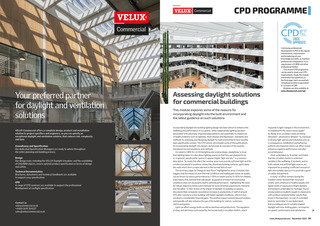


SPONSOR CPD PROGRAMME Assessing daylight solutions for commercial buildings Continuing professional development (CPD) is the regular maintenance, improvement and broadening of your knowledge and skills, to maintain professional competence. It is a requirement of CIBSE and other professional bodies. This Journal CPD programme can be used to meet your CPD requirements. Study the module and answer the questions on the final page. Each successfully completed module is equivalent to 1.5 hours of CPD. Modules are also available at www.cibsejournal.com/cpd This module explores some of the reasons for incorporating daylight into the built environment and the latest guidance on such solutions Incorporating daylight into building lighting design has been shown to enhance the wellbeing and performance of occupants, while inappropriate lighting has been associated1 with adversely impacted sleep patterns and potentially increased risk of health problems such as diabetes, heart disease and depression. Standards and methods for assessing and designing daylight for built environments have recently been significantly revised. This CPD article will consider some of the justifications for incorporating daylight into design, and provide an overview of the recently introduced recommendations and methods. As noted in CIBSE SLL LG 10 Daylighting and window design, daylighting is more than lighting tasks: it is also about lighting spaces so that they are pleasant to be in. In general, people prefer spaces to appear bright; light and airy is a common description. To create this effect the window area must provide sufficient light and the windows be placed in positions where they illuminate building surfaces, particularly the walls which form a major element in the normal field of view. The summary paper by Wargocki and Wyon2 highlighted an array of studies that suggest that the impact of poor thermal conditions and inadequate indoor air quality can be shown to reduce performance by 5-10% for adults and by 15-30% for children. Importantly, they advised that individuals acceptance of indoor environmental conditions does not necessarily lead to optimal performance highlighting the need for robust, objective metrics and methods for environmental assessments. Edwards and Torcellini,3 in their review of the impact of daylight on building occupants, discovered that companies recorded an increase in productivity of staff of around 15% after moving to a new building with better daylight conditions, which in turn resulted in considerable financial gains. The positive impact extends beyond workers, and typically will also enhance the use of the building for visitors, customers, clients and guests. Light can affect energy levels as well as alertness and productivity. The regulation of sleep and alertness is processed by the human bodys circadian rhythm, which responds to light changes in the environment. As explained in the recent review paper4 by Reddy et al, circadian cycles are being disturbed advanced or delayed by exposure to diverse light spectra and intensities and, as a consequence, metabolism and behaviour patterns are impacted, which can affect mood, influence cognitive performance and alter social behaviour. Work undertaken by Acostaa5 concluded that the circadian rhythm is a decisive variable in the wellbeing of students, and so both natural and artificial light sources are important for providing a sufficient amount of light and suitable spectrum to promote a good circadian entrainment. A study6 of office workers during the Swedish winter showed that mood and vitality were enhanced in healthy people with higher levels of exposure to bright daylight, and research undertaken by Santiago7 found strong evidence students taught in classrooms with windows achieved better results than those in the basement. In a set of controlled tests by Jamrozika,8 it was determined that providing access to suitably shaded daylight and view, limiting glare, can improve occupants performance and satisfaction, www.cibsejournal.com December 2022 55 CIBSE Dec 22 pp55-58 CPD 209 VELUX Supp.indd 55 25/11/2022 16:19